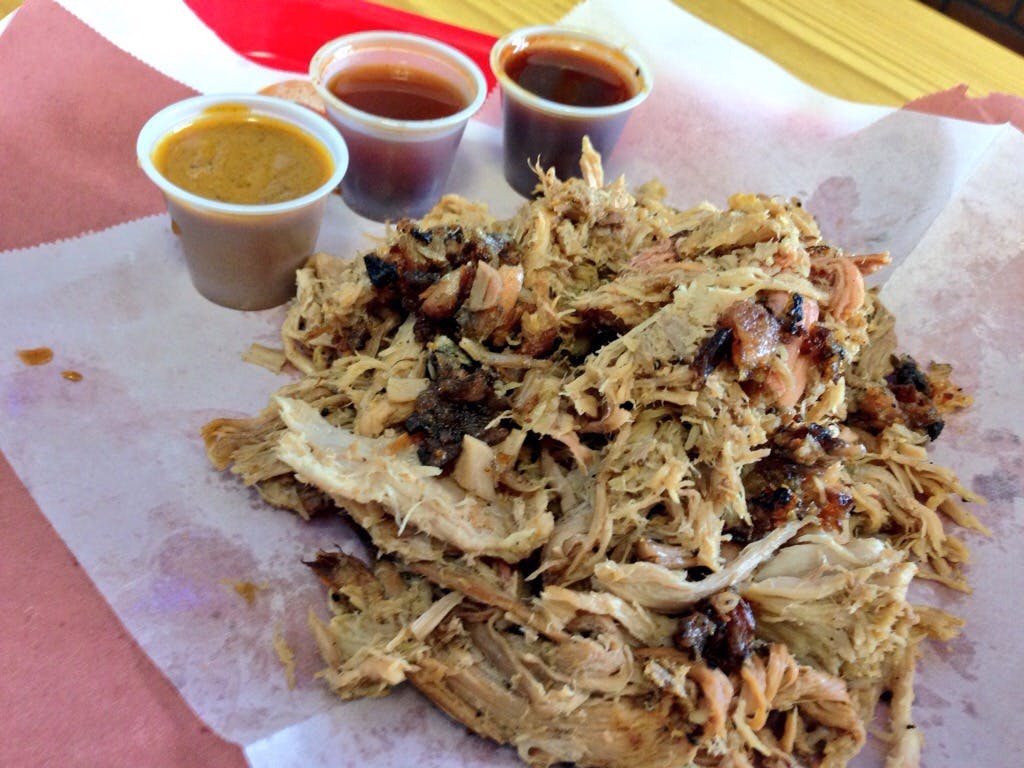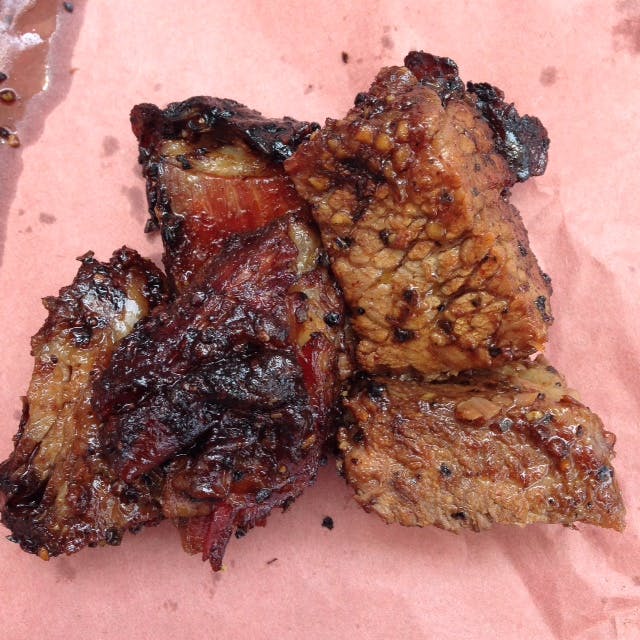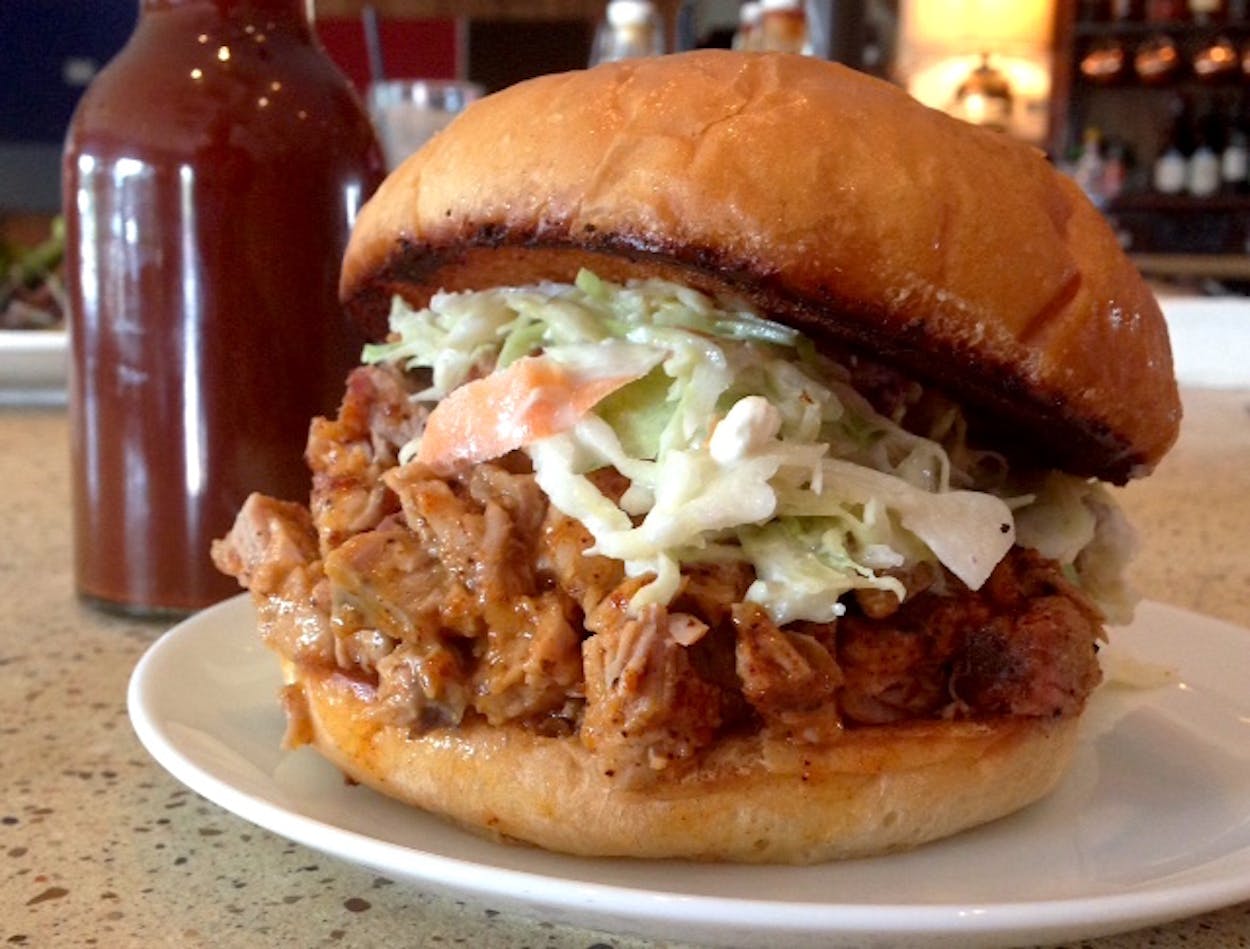“Barbecue is the closest thing we have in the United States to Europe’s wines or cheeses; drive a hundred miles and the barbecue changes.”
Barbecue historian John Shelton Reed wrote the above line just over a decade ago for an essay printed in the food writing collection Cornbread Nation 2, and in the time since, it has become an oft-repeated mantra for those proud of their local barbecue idiosyncrasies. But current trends are eroding the country’s barbecue boundaries. With every brisket added to a menu in North Carolina or whole hog cooked over coals in Texas, Reed’s statement is becoming less and less true. We are in the midst of a homogenization of barbecue across America, a trend similar to what linguists talk about when they lament the disappearance of regional dialects.
I’ve long noticed this flattening of barbecue culture, but a fine point was put on things for me recently. A cursory search on Foursquare for beef barbecue in North Carolina–O! That revered land of pork barbecue!–yields no fewer than fifteen options for smoked brisket in Charlotte, North Carolina. In Asheville, North Carolina, you can visit 12 Bones and find the stuff chopped or sliced; the Pit, in Raleigh, has served brisket since it opened in 2007. The same can be found further south, in Mount Pleasant, South Carolina, at Melvin’s Barbecue, as well as Home Team BBQ in Charleston, South Carolina, a restaurant that appears to worship the stuff. Even Texans have invaded the area, with John Lewis, of Austin’s La Barbecue, bringing his smoked briskets and beef ribs to well-attended pop-up events in South Carolina, a venture so popular it’s prompted him to open a Texas style-barbecue joint later this year in Charleston.
Perhaps this may not strike you as strange. But bear in mind that just two and half years ago, when I traveled to the Carolinas on a barbecue tour, Cook’s Barbecue was “the only … restaurant in Lexington, [North Carolina], to serve pit-cooked beef brisket,” according to Bob Garner’s Book of Barbecue (2012). (I tried it; it was serviceable.)
This tradition-swapping is a two-way street. Tim Byres and his team at Smoke, in Dallas, place a half-a-hog every into the kitchen’s Bewley smoker every day. It gets pulled to order for the pulled pork entrees, or it gets rough chopped for the North Carolina-style whole hog sandwich, served sauced up with a mis of mustard and vinegar sauces and topped with blue-cheese cole slaw. It’s fantastic, though it might not be straight out of the Carolina playbook. Regardless, it’s a passable option for any homesick mid-coaster. (A more traditional North Carolina whole hog is sometimes a special at Cattleack Barbecue, in Dallas.) In fact, almost every barbecue joint in Texas has realized that pork shoulder is de rigeur, the fashionable new item no modern menu should be without.

A glass-half-full mentality would argue that this just offers more options to the consumer. But John Shelton Reed isn’t ready to embrace all this uniformity just yet. The Southern Foodways Alliance produces the Gravy podcast, and it featured Reed on a recent episode about North Carolina barbecue. In it, he laments the homogeneity that he’s witnessing in current-day barbecue:
It’s a complicated story. Originally you had this uniformity everywhere in the 1850’s, or by the 1850’s and for some decades after that. But by the 1950’s it was an intensely local thing. I mean you drive 100 miles and the barbecue changes. You’re cooking different cuts of pork or not cooking pork at all, You’re using a different sauce. You can tell where you are by what the barbecue looks and tastes like. That was by 1950. Now increasingly we’re going, I’m afraid, I don’t like it, but increasingly we’re going back to uniformity this time presumably with thick, red, sweet sauces that line the surface like icing.
Reed is right to point out that it took a long time to develop distinct regional differences. Paw through enough old recipes, and you’ll find that most barbecue across America was prepared pretty much the same way by everyone who cooked it during the pre-Civil War era. The proteins and wood varied by region, but there weren’t definitive styles like we know today. It was the rise of the restaurant that formed these regional differences. Burnt ends were doled out in Kansas City; ketchup was added to the vinegar sauces of the Piedmont in western North Carolina; brisket rose above all other beef cuts as the choice of Texas pitmasters.
How did this happen? A steer didn’t just fall into fire in Lockhart one day, and everyone agreed that it would forever be known as Central Texas-style barbecue. These styles were transformed over time, passed down as tradition by a small circle of individuals who lived in close proximity to one another.
Without Bobby Mueller, celebrated pitmaster of Louie Mueller barbecue, in Taylor, there would be no peppery beef ribs, an item that has become a signature of Austin-area joints. The sausage links found in Southeast Texas can trace the lineage of their chile powder-and-garlic-infused recipes to Jack Patillo of Patillo’s Bar-B-Q in Beaumont. Carolina-style barbecue was codified by men like Warner Stamey in the west and Pete Jones in the east. Kansas City-style barbecue could be all chicken wings and smoked bologna if not for Henry Perry’s skill with a rack of ribs. My point is that barbecue traditions–and therefore styles–have been passed down by way of recipes and rules from one pitmaster to the next. Regional differences developed because most of the pitmasters learned from the same person or small group of restaurants. For decades, things rarely changed because the concentric circles around a center point were much tighter.
However, that radius has expanded greatly. No longer left only to tend fires and flip meat, pitmasters are now doubling as authors and television personalities. Consider Aaron Franklin, the famed pitmaster of Franklin BBQ, in Austin. On his show, BBQ with Franklin, he demonstrated how to cook whole hog. This is the man who is most revered for his skill with Texas-style brisket, who literally wrote the book on the subject. Barbecue’s media saturation is at an all-time high, with innumerable books, dozens of television shows, countless blogs, and hundreds of YouTube clips to be consumed. In this ever-connected world, learning about new barbecue styles is easier than ever. That’s why it’s no big surprise to see Kansas City-style burnt ends showing up on barbecue menus all over Texas, or to see Northern Alabama’s white sauce being served on smoked chicken from Atlanta to Austin. Heck, there’s even a whole hog barbecue joint in New York City.

Market forces also seem to be conspiring against regional varieties. It’s easier than ever for anyone in any part of America to pick up brisket or pork shoulder or baby backs or beef ribs or any other cut of meat one’s heart desires to throw on the pit. Speaking of cooking implements, pits–both indirect and direct heat–can be bought at the local grocery chain or hardware store. The techniques, ingredients, and equipment are all as ubiquitous as they’ve ever been.
Yet some seem determined to defy the leveled landscape of barbecue. I’m not talking about the legendary places; they don’t need to change. Newer barbecue joints are announcing their plans to buck homogeneity. Jim Shahin profiled some of these “neo-traditionalists” in a recent Washington Post article about North Carolina barbecue. You won’t find brisket on the menu at Elliot Moss’s Buxton Hall or at the soon-to-open Picnic, where Wyatt Dickson plans to stay true to the pork. They’ve made their intentions clear in a way that was unnecessary just a few years ago.
Until recently, nobody would have expected to see brisket on a North Carolina menu, in that same way that ten years ago, pulled pork on a Texas menu would have made waves. For me, I’ll happily get back to Smoke in Dallas for another whole hog sandwich with a side of brisket. I’m also giddy to try Moss’s whole hog in the mountains of western North Carolina at Buxton Hall, a dish I’ll get with a side of his South Carolina-style barbecue hash. Because who am I to deny a single plate that transports me around the country? It’s cheaper than airfare.








